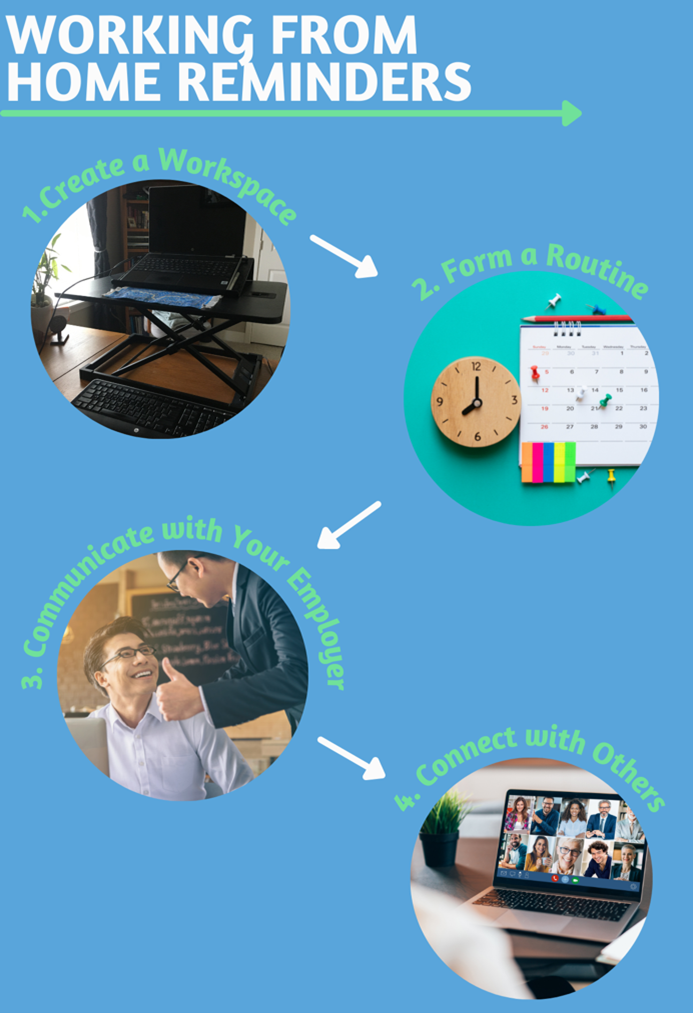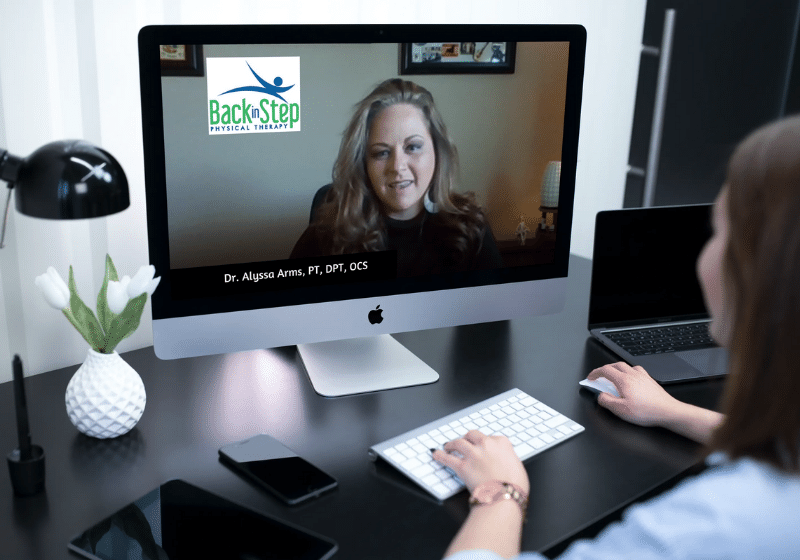Tag Archive for: health and wellness
Work Life Balance and Work from Home
As workdays shifted to our homes, our personal and work lives intertwine and surround identical key environments. After heading to the same kitchen table for our nine to five and midnight snacking, home can no longer feel like home. The line between these different worlds blur and the struggles of living in a pandemic are always knocking.
Days feel repetitive, work is overwhelming, and feeling like you’re in a rut is common occurrence for many employees nowadays.
Why is Work Life Balance Important?
It was reported that “66% of full-time employees in the U.S. do not strongly believe they have work-life balance.”1 Not only are workers feeling tired, but 190 billion dollars per year is spent on addressing the psychological and physical effects of burnout2. This means that working individuals are struggling to find a healthy work-life balance and the effects can be significant.
One of the main concerns of struggling with a work-life balance is the impact on physical and mental health. As physical and mental health coincide, it’s important to remember how these both work to affect our general wellness.
The Effects of Lack of Balance
For example, your boss has been making you work overtime to complete a project with a strict deadline. In order to finish the project, you’ve been staying up later and cutting your hours of sleep. Suddenly, you start to wake up with an aching back and an aggravating headache that coffee can’t seem to fix.
Even though the causes can vary, it is important to keep in mind that sudden influxes of stress and change can cause serious health implications. If you’re constantly stressed, physical symptoms can arise such as “headaches, upset stomach, high blood pressure, chest pain, and problems with sex and sleep”3. Therefore, it is necessary to understand the long-term effects that arise from your lack of health, and we want to minimize these impacts as soon as possible.
And yes of course, working from home can make you more productive, flexible with your own schedule, and has other benefits. However, if you aren’t experiencing many positives, keep in mind that adjusting to a new work life and the consequences of isolation is tough.

Thus, if you’ve been feeling burnout or stressed, here are ways to create a better work-life balance.
Create A Workspace
Before the pandemic, most of us had a designated workspace such as an office or cubicle, with immediate access to printers, high-end computers, and quick coffee machines. Because the switch to remote work was so swift, many of us didn’t have the time to personalize our workspaces.
Having an appropriate workspace is necessary for forming a balance between work time and free time. Whether it’s the corner of your dining room to the side of your bedroom, make sure your workspace can create boundaries. So, from 8:30 a.m. to 4:30 p.m. you are in one part of your home, and from 4:30 p.m. after, you’re spending time in other spaces of your home. This can help you feel like work and your home life are different realms.
For more information on how to upgrade your workspace, take a look at our extensive work from home toolkit with affordable options to make your workspace more comfortable.
Form A Routine
Routines can be helpful in times of uncertainty and stress. So, form a structured routine that can give you a sense of control. Remember to incorporate a sleeping schedule, an eating routine, and time for fitness to ensure you are prioritizing all of your needs. Keep in mind, flexibility is key and every day is different. Your routine may need to change to accomodate things that come up and that’s ok!
Communicate With Your Employer
Your employer knows COVID-19 has changed how their employees’ work. Whether the amount of work has increased, or you feel overwhelmed, remember that your needs are important. Contact your supervisor and discuss changes that could be helpful for both of you.
It is also important to check your employee guidelines and handbooks to see what options you have through your company, whether it’s things like workers compensation for injury, corporate wellness programs, and more.

Connect With Friends And Co-workers
Because work environments had active communication and our personal lives had plenty of social interaction, make sure you take time to connect with co-workers and friends. Reach out to a colleague or friend that you haven’t been able to see and plan a quick zoom lunch or an outdoor coffee meet-up. This way, you can take a breather and also see how others in your company/life are dealing with the pandemic.
Most importantly, you don’t need to be perfect!
It is important to understand that creating a work-life balance can be particularly hard when work AND personal life are at home. Self-care and forming a routine that suits you is the ultimate way to ensure you are meeting your best health.
If there are moments where you forget to take time for personal care, find ways to make sure that you prioritize yourself.
- Set reminders on your phone.
- Ask your significant other to keep you in check.
- Strict cut offs when your workday is done.
WANT MORE?
We are always happy to work with employees and reaching their ultimate health and wellness. If you are dealing with physical pains or issues, consider reaching out for professional help. We offer things like:
- On-site wellness services,
- Ergonomic assessments,
- On-site first aid, and
- Physical therapy for work injuries.

Guest Blog
Afraa Waheed is a third-year student at the University of Illinois at Chicago studying public health, psychology, and disability and health development. She is a passionate advocate for health equity and believes in providing the best care services to all communities. Afraa currently works as an intern for Back in Step Physical Therapy.
References:
Supporting Your Employees
It’s been over a year since the World Health Organization declared COVID-19 a pandemic. Within what seemed like a normal week in the middle of March, things suddenly changed. Millions of Americans lost their jobs or businesses. Children were sent home from school indefinitely. In a matter of days, everyone was forced to adjust to living a remote school, work, and personal life.
For employers, change was immediate. Sending hundreds of employees home with company laptops or cutting hours, employers witnessed the pandemic’s effect on their businesses. As they faced financial and clientele difficulties, many employers are seeing changes in their employees’ work performance.

In The Good Ole Days…
Life used to consist of waking up to a cup of coffee and commuting an hour to work via car or train. After heading to the daily 10 A.M. meeting, the day was spent collaborating with colleagues and supervisors. As soon as it hit 5 P.M., we’d return home to dinner and a movie with the family.
Now…
Work life consists of dragging ourselves from our fleece blankets and cozy couches to the uncomfortable kitchen table where we attend hour-long video calls for half the day. Most of our daily social interactions are limited to a wave at the Amazon delivery driver or our kid asking how to mute their mic during zoom class.
As millions of Americans now spend their nine-to-five isolated in a room crouched over a desk trying to maintain a semblance of their physical and mental well-being, remote work has produced changes to the business world we once knew.
The Effects
- Constant Isolation
- While usual days were full of brainstorming with coworkers and ongoing meetings, remote work can isolate employees from active communication with others. Employees’ work morale may decrease, feeling less connected to company needs and goals.
- Research has proved that loneliness can impact retention, productivity, and creativity in the workplace1. Furthermore, it was found that lonely workers are 5x as likely to miss work due to stress1. So the consequences of isolation in employee’s personal and work life inevitably effect their ability to be their best self at work.
- Unmonitored Performance
- It can become difficult to monitor employees’ progress through online platforms. As employees normally could walk a few feet to meet with a coworker or supervisor for assistance on a project, crafting a zoom meeting or planning a phone call delays progress. Since these small delays can build up, employees may miss key deadlines or postpone completion of work.
- Because self-regulation is primarily up to the employee, they must excel at being more independent. Without reminders from managers and the hustle of the workplace, performance levels can vary.
- Ergonomic Issues
- Since employees were abruptly sent home, it gave little time for individuals to sort out an appropriate workspace in their homes. Makeshift setups can be uncomfortable and employees are seated in these spots for hours.
- Several health issues have become more common from remote work impacts such as back or neck pains, headaches, and shoulder discomfort.
- If an employee begins to experience regular pain, they will likely want to seek out treatment. If it qualifies as a reportable injury, these costs may be on you as the employer.
Why This Matters?
A survey on U.S. remote working found that 55% of executives believe that most employees will continue working remotely at least once a week post-pandemic2. So, this is the new normal, and it’s best to figure out how to support your employees now.
Now, you’re probably wondering…
…Why is a physical therapy clinic talking about these things?
Here’s why:

We work with both employers and employees to keep work injuries at a minimum. In order to do that, we also believe in boosting corporate wellness, focusing on prevention and addressing things before they become a problem. Physical therapists are movement system experts. We understand what happens when the body is moving differently or not moving much at all.
Since remote work may be creating new challenges for your employees’ bodies, we can recommend things like changes in personal work set ups or preventive exercise routines. This can ultimately help employees feel more comfortable during their work days so they can be even more successful!
Keep reading to learn more about some of our recommendations for you – the employer.
What Can You Do You?
-
Promote employee wellness
Employees rely on you for things like healthcare and other benefits. So why not create a workplace culture that establishes the tone of supportiveness and understanding? Employees are not only motivated to stay engaged but are physically and mentally healthy.
Our Recommendation
Introduce health and wellness services for your employees. This could include online options for those that work from home or in-person options for those in the office.
For reportable injuries, consider what options are available to your employees as well. If they’re working remotely, maybe they’d prefer telehealth, which is an online format for health care. It’s a resource that can quickly help your employees with whatever medical concerns they have. There are even options to assess ergonomic issues and resolve concerns before they get worse.
Health and wellness services can prevent employees from developing serious health implications, whether they’re work related or not. This can reduce the company’s future healthcare costs and promote general employee wellness.
-
Build a sense of belonging
In a study by The Wall Street Journal, it was found that one of the more important factors that create successful companies is when employees feel a sense of belonging3. Your employees want to feel heard and that their voice matters, so produce an environment where sharing knowledge or concerns is routine.
Communicate actively by setting up virtual meetings to discuss or remind employees of their deadlines, answer questions, and consider what form of communication works best for them (email, texts, phone calls, zoom calls, etc).
Our Recommendation
Find group activities that work for your employees, with both in-person and remote options. This could include things like:
-
- Online workouts,
- Yoga sessions,
- Sessions to learn mindfulness or meditation, or
- Lunch-and-learn seminars, full of bonding exercises and helpful tips.
-
Set expectations early
Provide guidelines, set boundaries, and clear goals for employees early on.
Our Recommendation
-
- Make it clear to employees about the health and wellness services available to them and how to access them. This includes how reporting workers compensation injuries works, particularly if they’re working remotely.
- Let them know how the company is supporting them to be successful, to feel connected, and to show concern for their general well-being.
Want more?
We are always happy to work with companies, helping them be successful by supporting their employees’ health and wellness. We offer things like:
- Safety training,
- On-site wellness services,
- Ergonomic assessments,
- On-site first aid, and
- Physical therapy for work injuries.
You can also check out our entire Work from Home Kit.
Learn more on our Corporate Wellness page or contact us.
References
Guest Blog
Afraa Waheed is a third-year student at the University of Illinois at Chicago studying public health, psychology, and disability and health development. She is a passionate advocate for health equity and believes in providing the best care services to all communities. Afraa currently works as an intern for Back in Step Physical Therapy.
We’d also like to acknowledge Nick Hopkins, SPT, student physical therapist at the University of Colorado for his help with this article.
Back In Step Physical Therapy
6551 S Revere Pkwy, Ste 215
Centennial, CO 80111
(303) 960-2075
info@backinsteppt.com
